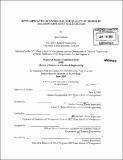| dc.contributor.advisor | Charles Cooney and Roy E. Welsch. | en_US |
| dc.contributor.author | Matthew, Julie (Julie Elizabeth) | en_US |
| dc.contributor.other | Leaders for Manufacturing Program. | en_US |
| dc.date.accessioned | 2009-12-10T19:10:05Z | |
| dc.date.available | 2009-12-10T19:10:05Z | |
| dc.date.copyright | 2009 | en_US |
| dc.date.issued | 2009 | en_US |
| dc.identifier.uri | http://hdl.handle.net/1721.1/50084 | |
| dc.description | Thesis (M.B.A.)--Massachusetts Institute of Technology, Sloan School of Management; and, (S.M.)--Massachusetts Institute of Technology, Dept. of Chemical Engineering; in conjunction with the Leaders for Manufacturing Program at MIT, 2009. | en_US |
| dc.description | Includes bibliographical references (p. 76-78). | en_US |
| dc.description.abstract | Quality by Design (QbD) is a systematic, science-based approach to pharmaceutical development that was defined in the International Conference on Harmonization (ICH) Q8 guideline in 2005. Expectations are that QbD will ultimately become a regulatory expectation and prerequisite for drug approval. The pharmaceutical industry has made significant progress in applying QbD principles for small molecules, and efforts to adapt the new paradigm to biologic products are gaining momentum. Although the primary motivation for adopting QbD is regulatory expectation, the business impact of QbD has not yet been defined. The purpose of the business case is to examine the internal impact of QbD using Amgen, Inc. as a model large biopharmaceutical company. This assessment aims to identify the most critical areas of focus and to align expectations around the impact of QbD. The business case captures the impact of QbD throughout the commercialization process, from drug discovery to commercial production, by applying a conceptual framework that divides the commercialization process into four major elements: Molecule Selection, Process Development, Technology Transfer, and Marketing Application & Commercial Production. Examples of on-going activities were identified within each of these elements to estimate the economic and operational impact of QbD. One of these examples was based on a deep-dive technical analysis of Smart Freeze Dryer technology, a novel means of lyophilization cycle development and temperature control. | en_US |
| dc.description.abstract | (cont.) The business case demonstrated that internal drivers do exist for the systematic implementation of QbD. Up-front investment early in the product life cycle offers economic and operational benefits later in development and commercial production. In addition, organizational learning and process development evolution lead to cumulative benefits for subsequent pipeline products. Though the magnitude and timing of investment depends on the available resources and long-term strategy of the business, investment should be concentrated in three key areas: Science & Technology, Knowledge Management Systems, and Business Processes. | en_US |
| dc.description.statementofresponsibility | by Julie Matthew. | en_US |
| dc.format.extent | 80 p. | en_US |
| dc.language.iso | eng | en_US |
| dc.publisher | Massachusetts Institute of Technology | en_US |
| dc.rights | M.I.T. theses are protected by
copyright. They may be viewed from this source for any purpose, but
reproduction or distribution in any format is prohibited without written
permission. See provided URL for inquiries about permission. | en_US |
| dc.rights.uri | http://dspace.mit.edu/handle/1721.1/7582 | en_US |
| dc.subject | Sloan School of Management. | en_US |
| dc.subject | Civil and Environmental Engineering. | en_US |
| dc.subject | Leaders for Manufacturing Program. | en_US |
| dc.title | Developing the business case for Quality by Design in the biopharmaceutical industry | en_US |
| dc.type | Thesis | en_US |
| dc.description.degree | S.M. | en_US |
| dc.description.degree | M.B.A. | en_US |
| dc.contributor.department | Leaders for Manufacturing Program at MIT | en_US |
| dc.contributor.department | Massachusetts Institute of Technology. Department of Chemical Engineering | |
| dc.contributor.department | Sloan School of Management | |
| dc.identifier.oclc | 458558458 | en_US |
